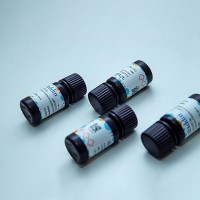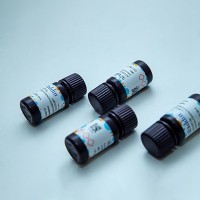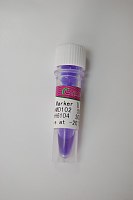Preparation of Fluorescent DNA Probe from HUMAN mRNA or Total RNA using Direct Incorp
互联网
Preparation of Fluorescent DNA Probe from HUMAN mRNA or Total RNA using Direct Incorporation (Max Diehn/Ash Alizadeh protocol; 3/15/01)
I. Preparing fluoresenctly labeled cDNA (probe):
-
To anneal primer, mix 2ug of mRNA or 50-100m g total RNA with 4ug of a regular or anchored oligo-dT primer in a total volume of 15.4 ul:
Cy3
Cy5
mRNA (1 g/l )
x l
y l (2 m g of each if mRNA, 50-100m g if total RNA)
Oligo-dT (4 g/l )
1 l
1 l
(Anchored: 5'-TTT TTT TTT TTT TTT TTT TTV N-3')
ddH2 O (DEPC)
to 15.4 l
to 15.4 l
Total volume:
15.4 l
15.4 l
- Heat to 65 o C for 10 min and cool on ice.
-
Add 14.6 m L of reaction mixture each to Cy3 and Cy5 reactions:
Reaction mixture
l
. . . . .
Unlabeled dNTPs
Vol.
Final conc.
5X first-strand buffeundefined
6.0
dATP (100 mM)
25 uL
25 mM
0.1M DTT
3.0
dCTP (100 mM)
25 uL
25 mM
Unlabeled dNTPs
0.6
dGTP (100 mM)
25 uL
25 mM
Cy3 or Cy5 (1 mM, Amersham)
3.0
dTTP (100 mM)
10 uL
10 mM
Superscript II (200 U/uL, Gibco BRL)
2.0
ddH2O
15 uL
Total volume:
14.6 l
Total volume:
100 uL
- Incubate at 42o C for 1 hr.
- Add 1 l SSII (RT booster) to each sample. Incubate for an additional 0.5-1 hrs.
- Degrade RNA and stop reaction by addition 15 m l of 0.1N NaOH, 2mM EDTA and incubate at 65-70 o C for 10 min. If starting with total RNA, degrade for 30 min instead of 10 min.
- Neutralize by addition of 15 m l of 0.1N HCl.
- Add 380 m l of TE (10mM Tris, 1mM EDTA) to a Microcon YM-30 column (Millipore). Next add the 60 m l of Cy5 probe and the 60 m l of Cy3 probe to the same microcon. (Note: If re-purification of cy dye flow-through is desired, do not combine probes until Wash 2.)
- WASH 1: Spin column for 7-8 min. at 14,000 x g.
- WASH 2: Remove flow-through and add 450 ul TE and spin for 7-8 min. at 14,000 x g. It is a good idea to save the flow trough for each set of reactions in a separate microcentrifuge tube in case Microcon membrane ruptures.
- WASH 3: Remove flow-through and add 450 ul 1X TE, 20 m g of Cot1 human DNA (20 m g/ m l, Gibco-BRL), 20 m g polyA RNA (10 m g/ m l, Sigma, #P9403) and 20 m g tRNA (10 m g/ m l, Gibco-BRL, #15401-011). Spin 7-10 min. at 14,000 x g. Look for concentration of the probe in the microcon. The probe usually has a purple color at this point. Concentrate to a volume of less than or equal to the volume listed in the "Probe & TE" column in the table below. These low volumes are attained after the center of the membrane is dry and the probe forms a ring of liquid at the edges of the membrane. Make sure not to dry the membrane completely!
-
Invert the microcon into a clean tube and spin briefly at 14,000 RPM to recover the probe.
Select the appropriate row from the table:
Cover Slip Size (mm) Total Hyb Volume (m l) Probe & TE (m l) 20x SSC (m l) 10% SDS (m l) 22 x 22 15 12 2.55 0.45 22 x 40 25 20 4.25 0.75 22 x 60 35 28 5.95 1.05 - Adjust the probe volume to the value indicated in the "Probe & TE" column above.
- For final probe preparation add 4.25l 20XSSC and 0.75 l 10%SDS. When adding the SDS, be sure to wipe the pipette tip with clean, gloved fingers to rid of excess SDS. Avoid introducing bubbles and never vortex after adding SDS.
- Denature probe by heating for 2 min at 100 o C, and spin at 14,000 RPM for 15-20 min.
- Place the entire probe volume on the array under a the appropriately sized glass cover slip.
- Hybridize at 65o C for 14 to 18 hours in a custom slide chamber with humidity maintained by a small reservoir of 3X SSC (spot around 3-6 l 3X SSC at each corner of the slide, as far away from the array as possible).
II. Washing and Scanning Arrays:
- Ready washes in 250 ml chambers to 200 ml volume as indicated in the table below. Avoid adding excess SDS. The Wash 1A chamber and the Wash 2 chambers should each have a slide rack ready. All washes are done at room temperature.
-
Wash Description Vol (ml) SSC SDS (10%) 1A 2x SSC, 0.03% SDS 200 200 ml 2x 0.6 ml 1B 2x SSC 200 200 ml 2x -- 2 1x SSC 200 200 ml 1x -- 3 0.2x SSC 200 200 ml 0.2x -- - Blot dry chamber exterior with towels and aspirate any remaining liquid from the water bath.
- Unscrew chamber; aspirate the holes to remove last traces of water bath liquid.
- Place arrays, singly, in rack, inside Wash I chamber (maximum 4 arrays at a time). Allow cover slip to fall, or carefully use forceps to aid cover slip removal if it remains stuck to the array. DO NOT AGITATE until cover slip is safely removed. Then agitate for 2 min.
- Remove array by forceps, rinse in a Wash II chamber without a rack, and transfer to the Wash II chamber with the rack. This step minimizes transfer of SDS from Wash I to Wash II.
- Wash arrays by submersion and agitation for 2 min in Wash II chamber, then for 2 min in Wash III (transfer the entire slide rack this time).
- Spin dry by centrifugation in a slide rack in a Beckman GS-6 tabletop centrifuge at 600 RPM for 2 min
- Scan arrays immediately.







